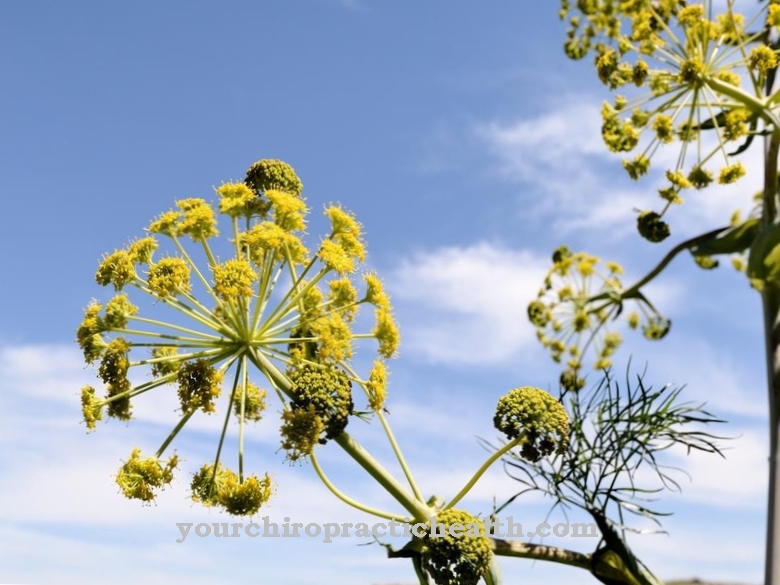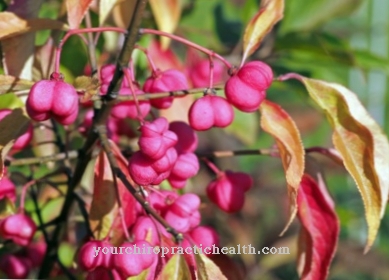Occurrence and cultivation of the sweet umbel

The Sweet umbel is a perennial that grows between 60 and 200 centimeters. It has very large stalked leaves that are hairy on the lower side. Sweet umbels smell strongly of anise, their umbels consist of up to 24 rays and are partly hermaphroditic or partly purely male. The petals of the flowers are white, edged and inverted heart-shaped.
The fruit of the sweet umbel reaches a length of about 15 to 25 millimeters and has a dark brown color. The sweet umbel is a hardy plant and a so-called frost germinator, which means that the seeds only germinate after a few cold winter months. If you want to plant the umbel yourself, you should choose a partially shaded place, the soil should be acidic or damp and regularly watered and weeded. In the spring, the dried or frozen parts are cut off and over time a relatively tall perennial develops.
In addition, the plant can also be purchased from a specialist nursery. Sweet umbels bloom from May to June and are originally found in the Alps, on the western side of the Balkan Peninsula, in the Apennines and Pyrenees. They can also be found in wild form in Chile, for example. Mostly the plant grows in grass gardens, fat meadows, on pastures, on the edges of forests or in alluvial forests, preferring calcareous soils.
In German vernacular, the sweet umbel is also called Myrrh chervil otherwise there are no special legends and sagas surrounding the plant. In old herbal books it can be read that a special tonic for girls was made from the roots of the sweet umbel, but it does not tell what it was used for. The sweet umbel contains essential oils that are very rich in methylcharicol or anethole.
In some Scandinavian or Western European countries, the plant is also called Spanish chervil, the term presumably due to its western Mediterranean origin. For many centuries the sweet umbel has also been grown in farm and monastery gardens as a medicinal, spice, cattle feed and vegetable plant. Many farmers are convinced that the sweet umbel stimulates the milk production of the cows. Due to its tolerance to cold, it is particularly popular in Scandinavia, as the residents can use a tasty herb all year round.
Effect & application
The essential oils contained in sweet umbels have an antispasmodic, digestive and stomach-strengthening effect. In addition, the plant also has a positive effect on the upper respiratory tract, stimulates the appetite and is also used for blood purification.Because of its expectorant effect, it was previously used against coughing and against old age.
The seeds of the sweet umbel are reminiscent of liquorice and are a very effective agent for gum care and against bad breath. It is best harvested at lunchtime in warm weather, because then a lot of aromatic substances are formed. The leaves can then be stripped from the stems and dried. However, the aroma is somewhat lost during drying, so that the fresh plant is particularly recommended for tea.
Importance for health, treatment & prevention
The sweet umbel leaves can be harvested and eaten in autumn or spring. The seeds are often used as a spice. The sweet umbel has an anise-like taste and can be used for fish dishes, sauces or salads. The fruits are used to refine pastries and cabbage dishes. The seeds of the sweet umbel can be eaten pure.
The mucous membrane absorbs the active substances it contains immediately, which dissolves mucus and refreshes the breath. The green seeds are a very special delicacy because they have an extremely aromatic taste and can also be used for muesli, desserts or fruit salads when chopped. In compotes, fruit dishes or fruit salads, sugar consumption can also be reduced with the help of sweet umbels.
It is also possible to prepare a vegetable from the roots of the plant or to finely cut the boiled roots and then season them with a marinade of vinegar and oil. In addition, the sweet umbel is part of various liqueurs and chartreuse and can be combined very well with bay leaves, mint or lemon balm. For a tea, two teaspoons of the sweet cone seeds are crushed in a mortar, mixed with cold water and then brought to the boil.
The tea has to steep for five minutes and is then strained. One or two cups can then be drunk throughout the day. Another option is to steam the leaves of the plant in butter and then serve with boiled potatoes. The plant is also known in homeopathy and is used here as Myrrhis ordata for hemorrhoids or varicose veins.
The drug is mostly used in potencies D2, D3 or D4. If you want to make a medicine, you put the fresh herb in an alcohol solution. The ointment form is also recommended for hemorrhoids, while the drops are suitable for other complaints. Sweet umbels are also used as fragrant plants for scented bouquets, potpourris or scented gardens.

























.jpg)


